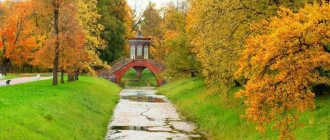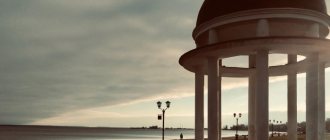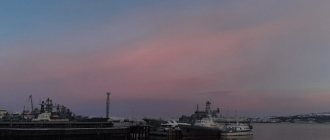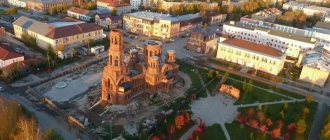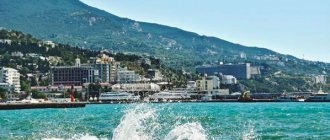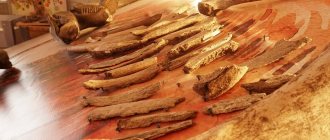Sergey Glezerov City October 08, 2019
For most St. Petersburg residents, Peterhof is a museum-reserve, palaces and fountains. And behind them is a working watch factory and a developing science city. But few people think that it is also a satellite city with its own characteristics and traditions, in which almost one hundred thousand inhabitants live. Our interlocutor Elena KORSHUNOVA, an architect by training who works in the field of interior design, has been living in Peterhof for three years. Moreover, according to her, having moved from St. Petersburg to the suburbs, she made an absolutely conscious choice and does not feel disappointed.
The Petrodvorets watch factory has lost its former power, but its tower remains one of the symbols of the city. PHOTO by Alexander DROZDOV
— If you read local social networks, you may get the impression that Peterhof is some kind of “black hole.” Transport collapse, undeveloped social infrastructure, the dominance of tourists, noise from low-flying planes...
— In fact, networks sometimes exaggerate things. Peterhof has everything you need: a clinic, a hospital, cinemas, shops, sports clubs, restaurants. Peterhof as a whole is a fairly clean city: garbage is collected, lawns are regularly mowed. Lots of children's playgrounds.
As for my personal choice: I wanted to be closer to my favorite parks and palaces. Beautiful nature, clean air. There are many historical monuments around. I like the low-rise buildings in New Peterhof - where I live: there is no feeling that you are living in an “anthill”, the architecture is not overwhelming. The new neighborhoods have pleasant neighbors - mostly married couples with children.
And it’s convenient to get to the metropolis by train: we live not far from the station, it’s convenient to calculate the time, “Swallow” runs regularly.
- Is it really an idyll?
- No, of course not. First of all, there are problems with the same transport. From Peterhof there is an exit to the Ring Road; the city can be reached by car in 30 - 40 minutes. But that's if there are no traffic jams. But those who travel during rush hour experience great inconvenience. There are not enough additional exits from new buildings to Ropshinskoye Highway. And in general, there is a problem with travel to new neighborhoods.
Historically, the city was divided in two by railroad tracks. And in order to get from its eastern side to the St. Petersburg Highway, which connects Peterhof with the city, you need to overcome three crossings - along the Ropshinskoye Highway and at the New and Old Peterhof train stations.
It would seem that everything is obvious: we need to build a viaduct across the railway. But then the territories of UNESCO World Heritage Sites and monuments of federal significance will have to be affected. There is an idea to make a tunnel under the railway instead of a viaduct, but this is too complex a project and is unlikely to be implemented in the foreseeable future...
Related article:
Three Peterhofs and a Bird. How the city has changed over several decades
The railway in the middle of Peterhof is also a problem for pedestrians who need to cross the tracks. Particularly affected are groups of the population with limited mobility: the existing underground pedestrian crossing is clearly unsuitable for them (large slope), and the overpasses are full of holes and potholes. If the number of trains increases (especially freight trains, there are rumors about this), this problem will become much more serious.
— You can read a lot on the Internet about the threat of overpopulation in Peterhof. Especially because of the plans to build new neighborhoods on the continuation of Botanical Street. There will be more than 20 thousand new residents, and old-timers are worried that the local infrastructure is simply not created for so many people: neither social, nor medical, nor transport. There is a group on the networks called “Peterhof Collapse”...
- Alas, there are reasons for concern. Local residents are also concerned about plans for multi-storey development along the highway leading from St. Petersburg to Peterhof. Indeed, the population is growing much faster than the social infrastructure, and Peterhof, from a cultural suburb, risks turning into an ordinary “dormitory” area of St. Petersburg, only quite remote, peripheral, with all the ensuing consequences.
However, at the same time, when they say that there is no need to build new housing in Peterhof, I want to object: it is impossible to simply “freeze” our suburb in the form it is today. Because the influx of new people means hope for the emergence of new infrastructure facilities.
And now, for example, there are no longer enough schools. Also, Peterhof does not have its own maternity ward. I would really like to have swimming pools within walking distance - now you have to go to those located in local hotels, but they are expensive and not quite what you need...
In addition, there are actually not as many cultural centers within walking distance as we would like. Libraries serve as points of attraction; sometimes there are interesting events there. From time to time, good events are held in cultural.
— What about the museum-reserve?
— You see, in general one gets the feeling that the Peterhof residents are like a shoemaker without boots. In summer there is a crazy influx of tourists at the fountains, so we prefer to walk in parks that they rarely get to: primarily English, Kolonistsky and Lugovoy. In addition, not all local residents can afford to regularly pay for entrance to the Lower Park (a ticket costs 450 rubles). There are no benefits for Peterhof residents. It’s good that they have free entry to the neighboring Alexandria park (upon presentation of a passport) - that’s where we go. And everyone there is free after 17.00.
We can’t help but be glad that the Peterhof State Museum is becoming more and more popular every year, but we often get only one concern from tourists: buses parked in the wrong places, courtyards clogged with cars, garbage and trampled lawns. Residents accuse local authorities of not solving the situation, and officials, in turn, shrug their shoulders: they say, it’s not our competence...
The funds earned from tourists do not go to the local budget. And the city would clearly benefit from the money: many problems are not being solved due to lack of funding. In the neighborhoods of new buildings, there are problems with the installation of storm drainage; in the quarter called “Suvorovsky Town” (this is a monument of regional significance), abandoned buildings cannot be mothballed.
Desolation reigns in the ancient Holy Trinity Cemetery, where the first builders of Peterhof, heroes of the War of 1812, and other famous people are buried. Now a group of enthusiasts led by Yuri Dzyadzin is engaged in its restoration, but their strength and resources are clearly not enough. The list of local problems can go on for a long time...
I tried to get elected to municipal deputies, so I talked a lot with city residents. First of all, of course, they talk about their troubles. We always pay attention first of all to what worries us. Almost every yard has some kind of problem. Sometimes the administration is to blame, sometimes the management company is to blame, and there are also issues that can only be resolved at the city level.
#Peterhof #city #population
The material was published in the newspaper “St. Petersburg Vedomosti” No. 188 (6541) dated 10/08/2019 under the heading “There will be no collapse here.”
Share on VKontakte Facebook
Cool
Large cities 100-250 thousand people
Coat of arms of Kolpino
Kolpino
Population 144,288 people (2016).
Founded in 1722 next to the dam and sawmill built here in 1710, the city has been around since 1912. For three centuries it has been a major center of heavy engineering. The main enterprise of the city is the Izhora Plant, in the 18th-19th centuries. which produced materials and components for shipbuilding, and now produces equipment for petrochemicals and nuclear energy (including nuclear reactor vessels), metallurgical semi-finished products from steels with special properties, bridge and road metal structures.
Coat of arms of Pushkin
Pushkin
Population 102,729 people (2016).
Founded in 1710, city since 1808. Until 1918 - Tsarskoe Selo, from 1918 to 1937 - Detskoe Selo. One of the most famous imperial residences in the suburbs of St. Petersburg. The city is home to the famous Tsarskoye Selo palace and park ensemble, including the grandiose Catherine Palace and the Lyceum, where Alexander Pushkin studied. Nowadays it is a scientific, educational and tourist center.
Medium-sized cities 20-100 thousand people
Coat of arms of Peterhof
Peterhof
Population 78,457 people (2016).
Founded in 1705 as a “travel yard” (Petrov yard - German: Peterhof
), in 1710 the construction of the world-famous country residence of Peter I began here. The city has been in operation since 1762.
The Peterhof palace and park ensemble is famous for its numerous parks, ponds, canals and, most of all, intricate fountains and cascades of fountains. Here is the watch factory of the famous Raketa brand (founded in 1721 as the Peterhof Lapidary Factory). In the 1970s and 1980s. a suburban campus of St. Petersburg State University was built on the outskirts of the city. In 2005, Peterhof received the status of a science city. Coat of arms of Krasnoe Selo
Red Village
Population 54,422 people (2016).
Founded in 1714 by Peter I as a paper mill (factory) south of St. Petersburg, city since 1925. The settlement during the Imperial era was in the possession of the royal court. city since the year In the middle it turned into the summer military capital of the Russian Empire - large-scale military training and exercises took place here. For a long time there was a paper factory in the city, now there is a plastics factory on part of its territory.
Coat of arms of Lomonosov
Lomonosov (city)
Population 43,244 people (2016).
Founded in 1710 as Oranienbaum - the suburban residence of the first St. Petersburg governor A.D. Menshikov. City since 1780. Known for its palace and park ensemble - the largest ensemble of Peter the Great's Baroque in the suburbs of St. Petersburg. Due to the fact that Soviet troops managed to hold the famous Oranienbaum bridgehead during the Great Patriotic War, the city was not destroyed by the Germans, unlike the neighboring palace and park residences located along the famous Peterhof road.
Coat of arms of Kronstadt
Kronstadt
Population 43,005 people (2010).
Founded in 1704 as a fortified city on Kotlin Island in the Gulf of Finland, guarding the approaches to St. Petersburg. Already under Peter I it became a base for the Baltic Fleet and continues to play this role to this day. In 1983, Kotlin Island was connected to the mainland from the north by a dam along which a highway ran. In 2011, the dam also approached the city from the south.
Coat of arms of Sestroretsk
Sestroretsk
Population 40,090 people (2016).
Founded in 1714 as the country residence of Peter I, the city since 1925. In 1721-1724. The Sestroretsk arms factory was built here, along with a dam that formed a large reservoir. The plant was one of the main military-industrial enterprises of the Russian Empire, producing cannons, firearms, as well as civilian products. At the end of the 19th century, Sestroretsk turned into a dacha and sanatorium-resort area.
Peterhof
The territory on the site of Peterhof in the pre-Petrine era
The territories on the coast of the Gulf of Finland, in the Neva delta and near Lake Ladoga have been inhabited by Finno-Ugric tribes from time immemorial. In their language, this region was called Inkermaa (“beautiful land”). Already starting from the 10th century. it entered the possession of Veliky Novgorod, but remained a pagan, inaccessible region until the 17th century. The Novgorodians periodically repelled attacks from their German neighbors, the Swedes and Germans, and the most famous battle was the Battle of the Ice on April 5, 1242, with the participation of Prince Alexander Nevsky. In the next century, there were skirmishes with the Swedes, for whom the attempt to gain a foothold at the mouth of the Neva in the Landskrona fortress was ultimately unsuccessful.
The gradual strengthening of Moscow and the weakening of Novgorod under the control of mayors from among the boyar nobility led to the defeat of the Novgorodians in the Battle of Shelon in 1471 and the annexation of all the lands of the former veche republic to the Moscow principality. Among them was Inkermaa or, in the Swedish manner, Ingria. The land on which Peterhof later grew up was transferred first to the new mayor Ivan Geirot, and then to his associate A. V. Bestuzhev. The administrative center was moved to the new border princely fortress of Ivangorod, opposite the German Narva.
In 1617, possessions on the Neva were transferred to the Swedish crown under a peace treaty. The Moscow principality, devastated by the turmoil, could not resist this decision, and the Russians found themselves cut off from trade routes on the Baltic Sea. A close mentor of the Swedish king, Johann Skytte, was appointed governor of Ingria. Gradually, the Russian-speaking population was forced out of the Swedish province to the south, and Finnish settlements reappeared on the site of Russian villages located on the territory of the future Peterhof.
Revenge was taken only after the brilliant victory of Russian weapons in the Northern War under the leadership of Peter I. An interesting metamorphosis occurred with the name of the hill on which Petrodvorets was erected. Initially called Popova Gora, it began to be called Papigondo under the Swedes, and after the Russian victory over the Swedes, Peter named it in the Russian manner - “Babi Gon”, which gradually turned into the modern name Babigon Hill.
The emergence of the city and the origin of the name
Active construction along the shores of the Gulf of Finland began in the era of Peter the Great. On the site of former Finnish villages, “travel yards” and piers appeared, one of which was mentioned on July 12, 1705 in the emperor’s traveling journal under the name Peterhof. The origins of the name, which literally means “Peter’s Court” in Dutch, lie in the European toponymic tradition. It undoubtedly reflects the idea that Peter I had already had at that time to build his residence on this site.
In Peter’s times, the name Peterhof applied only to the palace complex, but by 1726, when an extensive infrastructure had developed around it and workers, engineers, peasants and military personnel settled, Peterhof acquired the status of a city.
Towards the end of World War II, on January 27, 1944, the city was renamed Petrodvorets in order to eliminate the obvious German-speaking sound. During the perestroika era, painful associations faded away, and in 1997, amendments to the law “On the administrative-territorial structure of St. Petersburg” divided Petrodvorets into the city of Peterhof and the village of Strelna.
Peterhof in the 18th century under Peter I
The official founding date of the city is 1705, when active landscape and architectural work began on the swampy coastal lowlands. The first wooden sovereign palace appeared in 1708, west of Marly, and existed until 1770. Peter's residence was located halfway between the new capital and Kronstadt under construction and was conceived as a symbol of victory in the war with Sweden and Russia's triumphant access to the Baltic Sea.
The architecture of the complex was not a simple imitation of modern European models, but was a striking example of the emerging original Russian art. Peterhof was conceived as a monument to the glory of Russian weapons, replete with many allegories that glorified the courage of Russian soldiers and ridiculed the enemy. Famous architects and sculptors M. Zemtsov, J. Leblon, N. Michetti, I. Braunstein, as well as engineer P. Saul and landscape architect L. Garnechfelst were involved in the project. Peter I himself actively participated in the development and discussion of the details of the project; many of the embodied artistic ideas belonged to him. Sometimes he specifically ordered architects to deviate from European standards in order to create unique creations.
The land plot was divided into the Upper Garden and the Lower Park, which were supposed to house numerous fountains. Such a plan was not typical for regular parks of that period. An unprecedented water pipeline from sources 22 miles from Peterhof and a system of powerful pumps were built especially for the unique water extravaganza.
The grand opening of the residence took place on August 15, 1723, 2 years before Peter’s death. It was a majestic celebration that found Russia at the peak of prosperity: victory in the Northern War was the last step to the status of an Empire. By the end of Peter's reign in Peterhof, the final layout of the Upper Garden and Lower Park, the palace with the Grand Cascade and the Canal, the Alley of Fountains, the Monplaisir and Marly palaces, as well as the Hermitage had already been completed.
Around Peter's residence, the estates of the closest imperial associates began to grow, among whom were Field Marshal J. Bruce and physician I. Blumentrost. In addition, the imperial palace ensemble was surrounded by residential settlements - Bolshaya (the future Old Peterhof) and Malaya. In 1721, the Peterhof Lapidary Factory was opened at the water mill, producing jewelry for the royal family. After the October Revolution, the enterprise was renamed the Petrodvorets Watch Factory. The famous watch brands “Zvezda”, “Pobeda” and “Raketa” originated from its lines.
Peterhof in the 18th century under the successors of Peter I
During the short reign of Catherine I, which lasted from 1725 to 1727, work continued in Peterhof to complete the already built palace complexes. In addition, new fountains “Triton”, “Favorite” and “Eve” appeared on the territory, and the empress herself served as the prototype for the latter. At the same time, large-scale construction of the Moncourage Palace began for the all-powerful favorite of the Peter the Great era, Prince A. D. Menshikov. However, this project of the famous architect M. Zemtsov was not completed - the disgraced minister went into exile in 1727.
Those around the new sovereign, young Peter II, were distinguished by extreme anti-Petrine and anti-Petersburg views, so the court soon returned to Moscow. For three long years it seemed that the star of northern Palmyra, and with it Peterhof, had finally set.
But already in 1730, with the accession of Empress Anna Ioannovna to the throne, the pendulum swung back, and the already experienced M. G. Zemtsov was again invited to Peterhof to continue construction work. The main merit of the architect was that, in addition to the construction of new palace fountains, he redesigned and streamlined the adjacent settlements and rebuilt some buildings into public premises: the Craftsman's Courtyard for peasants and the Cavalier's Courtyard for court servants. The vast territory that later became Alexandria and the English Park housed the imperial menagerie.
After the Palace Revolution of 1741, such famous architects as B. F. Rastrelli and B. Fok arrived in Peterhof, by order of Empress Elizabeth Petrovna. The English gardening style, which was gaining popularity, was reflected in the English Park designed by Giacomo Quarenghi and J. Meders. Elizabeth's successors on the throne, Catherine II and Paul I, also made a significant contribution to the expansion and decoration of the palace complex in Peterhof.
Peterhof in the 19th century
By the beginning of the 19th century. in the city adjacent to the palace there were already 57 philistine houses, 10 of them made of stone. Military personnel from the Life Guards of the Horse Grenadier, Uhlan and Dragoon regiments and the Caspian 148th Infantry Regiment were quartered in Peterhof. Lower court ranks and sailors lived in simple wooden houses. At the end of the 1820s. By order of Alexander I, dozens of the most unsightly buildings were rebuilt at public expense by famous metropolitan architects L. Ruska, V. Geste and V. Stasov. The city gradually expanded and became more comfortable.
In the years after the Napoleonic wars, the activity of the Cutting Factory temporarily fell into decline, but at the same time, its own paper production appeared in Petegrof.
The real flourishing of construction in Peterhof began after the accession of Nicholas I to the throne in 1825. The Tsar acquired the lands on which the menagerie of Anna Ioannovna's time was located and moved the animals to the English Park, thus freeing up the property for the construction of the Alexandria dacha, named after Empress Alexandra Feodorovna. The project, which resulted in a new landscape park and the Cottage Palace appearing in Peterhof, was led by the architect A. A. Menelas. In the 1830s. he was replaced by the architect I. Charlemagne, who rebuilt a number of Gothic houses and city buildings near the Upper Park. Along with this, local infrastructure developed: in the 1840s. A military hospital and government offices appeared in the city, and 30 years later - an almshouse designed by N. Benois. These objects were located on the territory of the so-called. Yegerskaya Sloboda, south of the English Park.
The traditions of A. Charlemagne to simultaneously develop both the palace and the city were continued by his follower A. I. Stackenschneider. Thanks, among other things, to their efforts, the expanded Peterhof received the status of a county town in 1849, however, it has always remained a quiet provincial oasis, dominated by private development. Second half of the 19th century. was marked by the appearance of many buildings in the classicist style, including the Palace of Leuchtenberg, erected for the daughter of Nicholas I, Maria, and her husband, the Duke of Leuchtenberg. At the same time, through the efforts of A. I. Stackenschneider, the German Colonist Park appeared, and on the islands of the Olgin Pond, picturesque pavilions grew up - Tsaritsyn and Olgin, in honor of the wife and daughter of the sovereign. The end of the century was crowned by the tireless activity of the talented architect N. Benois.
By 1836, Malaya Sloboda had become so enlarged that it was renamed St. Petersburg Forstadt (from the German “suburb”). By the end of the 19th century. in Peterhof there were already 387 residential buildings, of which only 70 were stone. The growth of the settlement was greatly facilitated by the branch of the Peterhof Railway, built in the 1850s. financed by the entrepreneur A. Stieglitz and connecting Peterhof with St. Petersburg. The opening of this section of the railway track took place on July 22, 1857, and by 1864 it was extended to Oranienbaum.
During the reign of Alexander III, the Peterhof complex was only slightly expanded, as the emperor preferred to spend time in Gatchina. Nevertheless, in 1885, the Lower Dacha appeared in Alexandria, designed by the architect A. Tomishko, which was intended for the prince, the future Nicholas II. In addition, at the end of the century, two gymnasiums were opened in Peterhof.
At the turn of the century, Nicholas II ordered the construction of barracks for the Dragoon and Caspian Infantry regiments. One of the most noticeable innovations for Peterhof and all of St. Petersburg was the power plant that grew to the west of Alexandria Park.
Peterhof / Petrodvorets in the 20th century
In 1905, the Orthodox Cathedral of Saints Peter and Paul was completed, built according to the design of the architect N.V. Sultanov, approved by Alexander III. The pyramidal temple, following the canons of Russian medieval architecture, became a picturesque dominant feature on the shore of Olga Pond.
With the Bolsheviks coming to power, the Peterhof palace and park ensemble was nationalized, and in 1918 the first excursions were held around the former imperial residence. By the mid-1920s. Peterhof's water supply system was put out of action due to financial difficulties and the devastating flood of 1924, which caused significant damage to the Lower Park. Reconstruction work, which continued until the war, helped restore some of the fountains and strengthen the structures of the Sea Canal and the Grand Cascade.
The living quarters, which were inhabited by palace servants, officers and soldiers, were gradually rebuilt into rest houses, sanatoriums and children's institutions.
The more than two-year period of fascist occupation, from September 1941 to the end of January 1944, caused enormous damage to Peterhof. The city was plundered and burned almost to the ground; about a third of the park trees were cut down and used to build anti-tank rubble. Many priceless works of art were stolen or destroyed, and only a small part of the park sculptures were removed from the palace park before the arrival of the Germans.
The restoration of Peterhof, to which the best forces of national culture were deployed after the war, continued until 1973. On November 26, 1973, the city was awarded the Order of the Badge of Honor in honor of the 250th anniversary and for the contribution of workers to the reconstruction of historical values and museum work. Outstanding Leningrad architects A. A. Ol, E. V. Kazanskaya, A. E. Gessen, sculptors V. L. Simonov, A. Gurzhiy, etc. took part in the restoration process. Already in 1946, 38 water cannons resumed operation in the central part of the palace complex, and in the 1950s. The central part of the city was replenished with new buildings and acquired a pre-war appearance. In 1954, the Peterhof Watch Factory was restarted. In subsequent decades, the city continued to grow through private development, including high-rise buildings, and came close to the railway track.
In the 1960s In Old Peterhof, construction began on buildings related to the educational and research structures of Leningrad State University. In 1971, the Faculty of Physics and the accompanying Research Institute of Physics were opened. In the second half of the 1970s. The scientific campus expanded to include the faculties of chemistry, applied mathematics and mechanical engineering. Research institutes engaged in scientific work in these areas and an astronomical observatory were built nearby. In the vicinity of the buildings, housing was also built for students, teachers and staff of scientific institutions.
Nowadays, the Peterhof Palace and Park Museum-Reserve, included in the UNESCO World Heritage List along with many other objects of the historical center of St. Petersburg, is a generally recognized tourist mecca. By the beginning of the 2000s. Most of the architectural monuments, such as the Belvedere, the Cottage in Alexandria, the Tsaritsyn and Olgin pavilions, and the regular layout of the Upper Garden and the Marlin ensemble of the Lower Park were completely restored. Delighted visitors are greeted by a real water extravaganza: there are a total of more than 170 fountains and 4 cascades in Peterhof. Many artistic treasures have been painstakingly reconstructed from surviving fragments, photographs and historical evidence. Large-scale restoration work continues to this day.
Coat of arms and flag of Peterhof
The modern coat of arms of the city, adopted by a resolution of the municipal council on December 24, 1998, is based on a historical design from 1831. Emperor Nicholas I personally approved the draft of the first official coat of arms of the Peterhof residence. The coat of arms depicts the gilded personal monogram of Peter I, composed of the first letters of the title Petrus Primus Imperator (“PPI”). Above it is the imperial crown.
Small towns of less than 20 thousand people
Coat of arms of Pavlovsk
Pavlovsk (St. Petersburg)
There are other meanings of this name, see Pavlovsk
Population 16,525 people (2016).
Founded in 1777 as the country residence of the future Emperor Paul I, the city since 1796. The city has a large palace and park ensemble also called Pavlovsk.
Coat of arms of Zelenogorsk
Zelenogorsk (St. Petersburg)
There are other settlements with this name, see Zelenogorsk
Population 14,968 people (2016).
It was first mentioned in 1548 as the Finnish fishing village of Terijoki. The city was founded in 1946 and received its modern name in 1948. Since the end of the 19th century it has been one of the dacha suburbs of St. Petersburg; in the 20th century it turned into a famous sanatorium and resort center.
State Museum-Reserve "Peterhof"
- The large cascade of Peterhof fountains - built in 1714-21, with a grotto, waterfall stairs, numerous bronze gilded statues, made by sculptors M. I. Kozlovsky, F. F. Shchedrin, I. P. Martos, F. I. Shubin and others .
- The Grand Palace, created in 1714-25 as Peter's Upper Chambers, was rebuilt in 1747-52 by V.V. Rastrelli in the Russian Baroque style.
- The upper garden has a regular layout, with the Neptune fountain.
- Lower park with a regular layout - 1714-25, architect I. F. Braunstein, J. B. Leblon, M. G. Zemtsov.
- Palace of Marly, built in 1720-23, architect Braunstein.
- The Hermitage Pavilion, erected in 1721-24, architect Braunstein.
- Colonnade pavilions, 1803, architect A. N. Voronikhin.
- English landscape park with Gothic and classical buildings - architect G. Quarenghi.
- Alexandria Park, architect A. A. Menelas.
- Meadow Park with the Belvedere Palace 1853-56, architect A. I. Stackenschneider.
Currently, 10 museums and 3 parks are open for viewing in Peterhof: Upper, Lower and Alexandria. There are 3 cascades and 173 fountains in the Upper Garden and Lower Park. Among them, the most popular are the unique joker fountains and machine-operated fountains, characteristic of regular parks of the Baroque era.
Upper Garden
- front gate
- Trellis gazebos
- Covered alleys (berso)
- Sundial
- Verkhnesadsky house
- Grand Palace (museum)
- Church building (church in the name of St. Apostles Peter and Paul)
- Corps under the Coat of Arms
- Mezheumny fountain
- Fountain Neptune
- Oak Fountain
- Square Ponds Fountains
Central part of the Lower Park
- Voronikhinsky colonnades
- Vases
- Large parterre flower beds
- Trellis gazebos
- Lastovaya Rota Barn (cafe)
- Antonov House (restaurant)
- Labyrinth
- Amphitheater
- Grand Cascade
- Upper Grotto
- Lower (Large) Grotto (Splash Table and Water Curtains)
- Fountain Samson
- Large fountains (Italian and French)
- Terrace fountains
- Fountains of Marble Benches
- Alley of Fountains
- Fountain Favorite
- Fountain Adam
- Fountain Eva
- Sand Pond and Whale Fountain
- Marina
Eastern part (Monplaisir)
- Monplaisir Garden
- Managerial garden
- Chinese garden
- Greenhouse garden
- Pyramid Garden
- Parterre garden
- Large greenhouse
- Western Aviary
- Eastern Aviary
- Monplaisir Palace Museum
- Palace-Museum "Catherine's Corps"
- Guest galleries
- Soapbox
- Museum "Bathhouse"
- Assembly Hall
- Tafeldekerskaya
- Kitchen Building Museum
- Sea terrace
- Neptune statue
- Greenhouse fountain
- Cascade of Dragons (Chess Mountain)
- Roman fountains
- Christmas tree fountain
- Fountain Umbrella
- Fountains Dubok
- Tulips and Benches
- Menagerny Pond
- Fountain Sun
- Bell Fountains
- Fountain Sheaf
- Fountains Sofa
- Fountain Sink
- Fountain Vase
- Fountain Pyramid
- Fountain Water Road
Balustrade "Monplaisir"
- Catherine II - marble. The work of an unknown sculptor of the 18th century.
- Neptune is copper. The work of master Arnold, 1716.
- Summer is marble. The work of an unknown sculptor of the 19th century.
- Amphitrite - marble. The work of an unknown sculptor of the 19th century. (according to ancient mythology, Amphitrite is the goddess and queen of the ocean)
Chinese kindergarten
- Antinous - marble. Statue. A 19th century copy of an antique original from the 2nd century BC.
- Cupid and Psyche - marble. A 19th century copy of the original by sculptor A. Canova. IN THE MONTPLASIR GARDEN
- Bacchus with Satyr - gilded bronze. Copy of 1817 from the original by J. Sansovino based on the model of I. P. Martos; cast by V.P. Ekimov.
- Satyr with a kid - gilded bronze. Copy of 1817 from an antique original of the 1st century BC according to the model of I.P. Martos; cast by V.P. Ekimov.
- Apollino - gilded bronze. Copy of 1817 from an antique original based on the model of I.P. Martos; cast by V.P. Ekimov.
- Psyche - gilded bronze. Copy of 1817 from the original by A. Canova based on the model of I.P. Martos; original by V.P. Ekimov.
Monplaisir Alley
- Monument to Peter I
- Bacchante - marble. The work of an unknown sculptor of the 19th century.
- Psyche is marble. A 19th century copy of the original by sculptor A. Canova.
- Bacchus - marble. The work of an unknown sculptor of the 19th century.
- Bacchante - marble. The work of an unknown sculptor of the 19th century.
- Antinous - marble. Copy from an ancient original of the 2nd century BC.
- Apollo - marble. A 19th century copy of an antique original.
Western part (Marlinskaya)
- Pavilion "Hermitage" (museum)
- Vases
- Garden of Bacchus
- Palace-Museum "Marly"
- Garden of Venus
- Earthworks
- Benois Family Museum
- Merchant harbor territory
- Lion Cascade
- Marlinsky Pond
- Marlinsky Cascade (Golden Mountain)
- Management fountains
- Triton fountains with water bells
- Sector ponds
Marlinskaya Alley
- Bust of a woman - marble. The work of an unknown sculptor of the 19th century.
Marlinsky kindergarten
- Pallas Athena - marble. Statue from 1846. (Athena - according to ancient mythology - the goddess of wisdom.)
- Marble bench-monument at the Lion Cascade
see also
- Saint Petersburg
- Cities of Russia
| [ + ] Cities by regions of Russia | |
| Cities of the North-West (NWFD) | St. Petersburg (and the cities within it ) • Leningrad region (historical Staraya Ladoga) • Arkhangelsk region • Vologda region • Kaliningrad region • Karelia • Komi • Murmansk region • Nenets Autonomous Okrug • Pskov region |
| Cities of the Volga region (Volga Federal District) | Bashkortostan • Volgograd region • Kalmykia • Kirov region • Mari El • Mordovia • Nizhny Novgorod region • Orenburg region • Penza region • Perm region • Samara region • Saratov region • Tatarstan • Udmurtia • Ulyanovsk region • Chuvashia |
| Cities of Southern Russia (SFD) | Sevastopol (including Inkerman) • Republic of Crimea • Adygea • Astrakhan region • Krasnodar region • Rostov region |
| Cities of the North Caucasus (NCFD) | Dagestan • Ingushetia • Kabardino-Balkaria • Karachay-Cherkessia • North Ossetia - Alania • Stavropol Territory • Chechen Republic |
| Cities of the Urals (Ural Federal District) | Kurgan region • Sverdlovsk region • Tyumen region • Khanty-Mansi Autonomous Okrug - Yugra • Chelyabinsk region • Yamalo-Nenets Autonomous Okrug |
| Cities of Siberia (Siberian Federal District) | Altai Republic • Altai Territory • Irkutsk Region • Kemerovo Region • Krasnoyarsk Region • Novgorod Region • Novosibirsk Region • Omsk Region • Tomsk Region • Tyva • Khakassia |
| Cities of the Far East (FEFD) | Amur Region • Buryatia • Jewish Autonomous Region • Trans-Baikal Territory • Kamchatka Territory • Magadan Region • Primorsky Territory • Sakha (Yakutia) • Sakhalin Region • Khabarovsk Territory • Chukotka Autonomous Region |
| see also | Cities of the DPR, LPR, Transnistria, South Ossetia • Regions of Russia • Cities of Russia |
Briefly about the modern appearance of Peterhof
The territory of Peterhof consists of two parks - Upper and Lower. The area of the upper park is 15 hectares. This territory contains a huge number of small gardens, gazebos, and flower beds. The center of the composition is mirror pools with fountains located in the center: • Mezheumny - a sea dragon surrounded by four dolphins; • Neptune; • Oak – Cupid surrounded by six dolphins; • Square ponds. The Upper and Lower parks are separated by the palace.
On the territory of the Lower Park there are 150 fountains and 6 huge cascades. The largest is the Grand Cascade. It is recognized as the largest cascade in the world - it includes 60 fountains and 250 sculptures.
In the center of the Big Cascade there are the Big and Small Grottoes. All water flowing through the Grand Cascade ends up in the Bowl.
The sea canal connects the Gulf of Finland to the Great Cascade, along which fountains are installed. The canal is the central axis of the Lower Park. Before the development of the Grand Cascade, the canal was navigable. Ships entered through it, bringing guests to the palace of the Summer Residence.
On the territory of the Lower Park there is a huge number of fountains in the form of sculptures, each of which tells its own story: Nymph and Danaid, Adam and Eve, Whale, Triton, etc.


